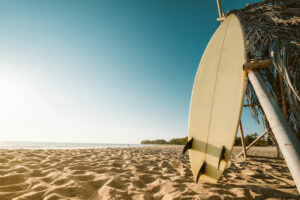Today, surfing is one of the most popular water sports in the world. It is a fun activity that makes you happier, less stressed and more balanced. The surfboard is a narrow board that provides solid support for the surfer as he or she rides the ocean waves. But there is the question “why do you wax a surfboard?”.
If you are a professional surfer, you need to know how to wax a surfboard in addition to maintaining a grip on the surfboard. Careful waxing is necessary to ensure a good grip between the surfer’s feet and the surfboard. Surfboard waxing is not rocket science. However, that doesn’t mean you don’t need to use the right methods to get the waxing right.
Key Takeaways:
- The different compositions of waxes, whose use depends on the temperature of the water.
- Techniques of how to apply your wax and what to consider while doing it
- DIY methods of how to take off the wax with some basic households tools at home
What is surfboard wax?
According to Wikipedia, surfboard wax refers to the “formulation of natural and/or synthetic wax for application to the deck of a surfboard, bodyboard, or skimboard, to keep the surfer from slipping off the board when paddling out or riding a wave.”
In simple words, it prevents the surfer from sliding off your surfboard while surfing across the waves.
What is a surfboard composed of?
Kerosene, beeswax or other solid compounds are commonly used to make surfboard wax. Vaseline can also be mixed in to make a softer wax. To give the wax an enticing scent, coconut or bubblegum is also added. There are also organic substitutes such as beeswax, vegetable oils, pine resin, tree pulp and pure essential oils.
A wide range of commercial brands and types of surfboard waxes suitable for different water conditions, geography and air temperature are also available on the market.
Water Temperature
| Water Temperature | Type of wax | Reason |
| Below 15 degrees Celsius | Cold water wax | Cold-water waxes provide the best possible grip despite low water temperature.It’s crucial to keep in mind that they should not be stored at high (or warm) temperatures because their quality can deteriorate under extreme heat. |
| 15 degrees Celsius to 19 degrees Celsius | Cool-water wax | Cool-water waxes, like cold-water waxes, are intended to maintain the board’s grip in colder conditions. Once the temperature starts to increase, they should not be utilized. |
| 19 degrees Celsius to 28 degrees Celsius | Warm water wax | Wax made from warm water is not heat-resistant.To get the most out of your board traction, follow the manufacturer’s application guidelines. |
| Above 24 degree Celsius | Tropical water wax | Tropical wax is designed for warmer climates.These waxes do not quickly melt if exposed to direct sunlight or subjected to higher temperatures. |
How to wax a surfboard in 10 Steps
There is no official method to wax your surfboard. But you can follow the steps below, you will always get a good result, especially the first times you prepare your surfboard:
- Place the surfboard in the shade (away from sunlight) to prevent the wax from melting.
- First clean your surfboard and remove old wax from the deck of the surfboard with a wax comb. Also remove any dust or dirt that is on the surfboard. This will help the surf wax adhere better. You can use a soft cloth or glass cleaning spray.
- Depending on the water temperature, choose the right type of wax (read the table above).
- Carefully apply a thin layer of primer. Do not rub the wax too hard, and keep the layer smooth.
- Apply the wax only to the area of your surfboard where you will be standing. You can use any of the four techniques described above.
- Also, apply some wax to the rails you’ll be holding onto if you have trouble keeping your surfboard under control in the water.
- Don’t apply too much wax so as not to put extra weight on your surfboard.
- When the wax wears off, you can use a surf comb to draw some marks in the old wax to restore traction.
- You can wipe off the wax on your surfboard and start over if it has doubled in thickness due to buildup.
- When the wax has softened, expose your surfboard to the sun and scrape it off with a wax scraper.
Waxing techniques or patterns
There are several techniques to wax your surfboard. Depending on which one you use, you can give your surfboard an individual touch or prepare it for special weather conditions. The 5 most popular techniques are as follows:
Straight line pattern
You apply the wax in a linear direction parallel to the board’s rocker.
Circular pattern
Start with small circular motions. Then, the wax is gently moved across the board upward and downward until bumps are visible.
Crosshatch pattern
Wax is applied in a diagonal grid pattern that crisscrosses. Using the edge of the base-coat wax brick, trace a line diagonally from one corner of the deck to the other, connecting from rail to rail. It is typically utilized to enhance the surfboard’s aesthetic appeal and design.
Freestyle pattern
As the name suggests, the wax is applied in a random pattern as per the desire of the surfer. The surfer can use a combination of the aforementioned patterns to create a design of their choice. The only thing to keep in mind is that all the areas on the board should be adequately covered.
How often should you apply wax to your surfboard?
You can wax your surfboard before each session and recommend that you spotless and re-wax your surfboard every two to three months. You should also clean your surfboard once a season, unless you surf every day.
Furthermore, you must also not allow the dirty wax to accumulate on top of the wax. Carefully remove the old and accumulated wax once or twice per season. Then apply a new coat. To ensure that the new layer of wax adheres well, you should completely remove the old wax.
How to remove wax from a surfboard?
To remove wax from your surfboard you can use either flour or wax remover, plastic scrapper, paper towel or a hair dryer:
Surfboard wax can be scraped off in big chunks using a plastic scraper. A soft cloth can be used to remove any remaining wax that has not been eliminated by scraping. An effortless method is to use the heat of natural sunlight. It lets the wax melt without any efforts in 15 to 20 minutes during midday.
At home, you can use a hair dryer or heat lamp to remove wax from the surfboard. Ensure it is on a low setting to avoid grill marks on the surfboard. You can use boiled water as a substitute to take off wax stains.
A very specific but effective tool is the wax comb. It is a versatile and handy tool for maintaining and removing wax from a surfboard. Wax combs have features such as a straight, moderately sharp edge and a serrated or jagged edge.
The straight edge is used to scrape off excess wax. The serrated edge is used to make rough grooves to improve the adhesion (grip) of the wax. In addition to the straight edge, some wax combs also contain an internally curved blade for removing wax. Wax combs may also include components such as a bottle opener, fin wrench, or portable push button.
Pro Tip:
Do not use chemical products so as not to damage the design and structure of the surfboard. Use flour or wax remover to remove the excess wax. Sprinkle the flour on the melted wax. Apply moderate pressure with a soft cloth to remove the remaining wax. Instead of flour, you can also use a mild detergent or cleaner.
Surfboard Wax vs. Traction Pads
Even today, the argument for and against surfboard wax and traction pads is a hot topic in surfing. Traction pads are better than surfboard wax in some ways. They don’t melt in the sun and also provide more grip than wax, which can be helpful for aerials, snaps and floaters.
xTail pads are the most popular option among traction pads brands. They act as gap fillers on the bottom of your board to prevent your feet from slipping. They show you where you should place your feet on the surfboard.
Why traction pads are better than surfboard wax
- One of the biggest advantages is that you don’t have to wax your surfboard when you use traction pads.
- Also, traction pads are easy to install, and you only have to put them on once. In contrast, you need to wax your surfboard very often, at least once every two months.
- A traction pad prevents scratches and dents because the foam of the pad protects the surfboard from strong waves. It helps extend the life of a fiberglass surfboard.
- Traction Pads help you ride smoothly through turns and twists.
- Traction Pads will soften your surfboard and provide a smooth surface for your feet. You will fully enjoy the comfort of soft foam under your feet.
But it’s expensive, and you have to put it in the right place. Many surfers attach traction pads to the tail of the surfboard to give their back foot extra support. The rest of the surfboard they wax in.
Pros of surfboard wax over traction pad
- Traction pads do not adhere properly to a soft surfboard. In this case, you just need to wax.
- You don’t need a traction pad if you want to surf a longer board.
- Some people enjoy the ritual of waxing their board before every surf session, which is not possible with a traction pad.
General Tips for waxing your surfboard correctly
Moderate pressure while applying wax will get you the best results. If you press too hard, you might over-apply the wax. But if you apply the wax too softly, it would be difficult to form a strong foundation also. Be aware that excessive use of wax may make your surfboard slippery. Wax only on the area where you will place the feet, and not throughout the top portion of the surfboard.
Select the right type of wax that gives a proper balance of traction and grip. It will improve the surfing performance and make it easier to glide through the waves. There are various types of wax available in the market-Base coat, Topcoat, sticky, etc. If the board does not have enough raised bumps after waxing, it was not done correctly, and you may have to apply additional wax. It provides more friction and keeps the surfer erect while surfing. Apply wax in the proper region with the proper pressure to produce wax bumps.
Best brands of surfboard wax
Below are some of the most popular brands that sell high-quality surfboard wax:
- Fu Wax.
- Bubble Gum Surf Wax.
- Mrs. Palmers Wax.
- Sticky Bumps Munkey Wax.
- Kassia’s Palo Santo Surf Wax.
- FCS Surf Wax.
- Mr Zogs
Conclusion: Why do you wax a surfboard?
Surfboard wax is crucial because it gives friction and grip to the surfer while surfing. A surfer may fall off their board without applying wax to the surfboard. You have different type of waxes, which you should choose carefully according to the water temperatures and your boards material. This can be done regularly. You can choose between traction pads and surfing pads.
Many surfers attach more expensive traction pads to the tail of the surfboard to give their back foot extra support. The rest of the surfboard they wax in. When you apply your new topcoat, the application technique is important to get a great grip to being able to perfect your surfing experience.









